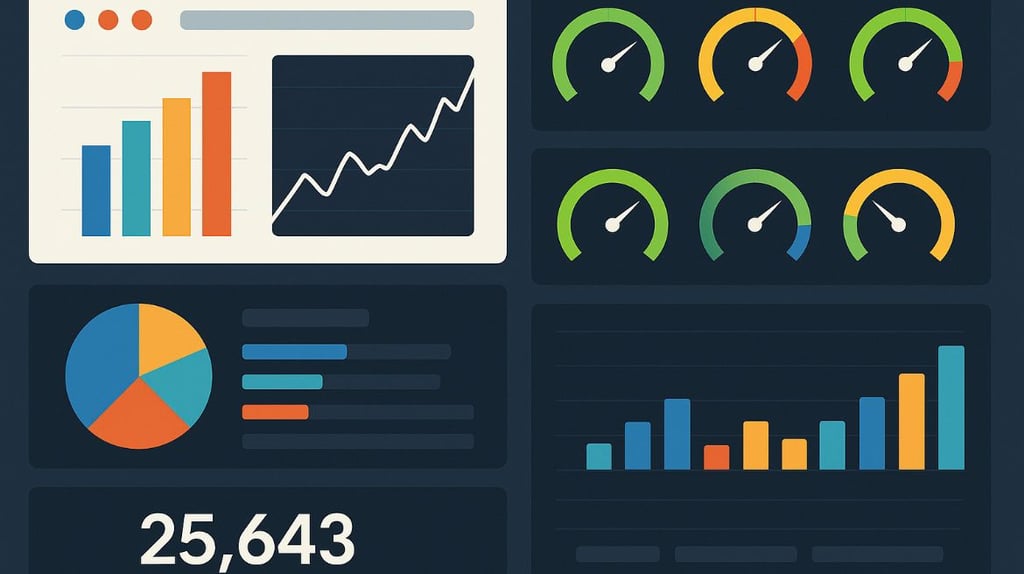
Master Tech skills on the go...
SEO Audit Checklist for SaaS Websites: Tools and DIY Guide
Comprehensive DIY guide to SEO audit checklist for SaaS websites: tools, step-by-step DIY guide, technical, on-page, UX and backlink audits to boost organic traffic and trial signups!
ONLINE INCOME & BUSINESS TOOLS
By OnlineTechSkills Editorial Team
5/22/20256 min read


Introduction
Growing a Software-as-a-Service (SaaS) business is an uphill climb and without visibility in search engines, even the most innovative solution can remain hidden in the digital shadows. Imagine launching a groundbreaking project management tool or a security platform with zero organic traffic: you’d rely solely on paid ads and word of mouth, driving up customer acquisition costs and limiting scalability.
This is precisely where a robust SEO audit comes in. By systematically examining technical setup, on-page content, user experience, backlink health, and analytics tracking, you can uncover hidden obstacles that hamper rankings and conversions. In this comprehensive guide, we’ll walk through a five-part audit framework tailored specifically for SaaS websites complete with actionable steps, recommended tools, and two brand-new mini case studies that illustrate how real-world SaaS companies turned their SEO around.
Whether you’re a marketer ready to dive into technical reports or a founder aiming to DIY your way to better search performance, this checklist will empower you to optimize effectively and sustainably.
Understanding SEO Audits for SaaS
SaaS websites face unique SEO challenges:
Subscription-driven conversion paths: Unlike transactional e-commerce, your primary goal is a free trial signup, demo request, or newsletter subscription. These actions require clear, relevant search intent alignment.
Complex site architectures: Multiple product pages, feature deep-dives, knowledge bases, and support portals can lead to crawl budget waste and content cannibalization.
Ever-evolving feature sets: Regular product updates and changelogs must be managed carefully to avoid duplicate or thin content.
A regular SEO audit:
Ensures that search engines crawl and index your key pages efficiently.
Identifies technical barriers such as slow loading times or mobile usability issues.
Highlights content gaps and optimization opportunities aligned with your buyer journey.
Reveals the health of your backlink profile and its influence on domain authority.
Verifies your analytics setup so you trust the numbers that guide decisions.
Five critical areas of SaaS SEO audit
1. Technical SEO
Technical underpinnings make or break your ability to rank. Even the best content won’t surface if Googlebot can’t navigate or if slow pages frustrate both users and search engines.
Core Audit Steps and Tools
i. Crawl and Indexation Check:
Tool: Screaming Frog SEO Spider (Free up to 500 URLs)
DIY: Run a crawl to reveal broken links (404s), redirect chains, and orphaned pages. Export your crawl report and filter URLs by status code.
ii. Robots.txt and Sitemap:
Verify that your "robots.txt" isn’t accidentally blocking key sections (e.g., `/docs/`, `/app/`).
Ensure your "XML sitemap" includes only canonical URLs and is submitted in Google Search Console.
iii. Mobile-Friendliness:
Tool: Google’s Mobile-Friendly Test and Lighthouse
DIY: Check viewport configuration, touch element spacing, and mobile font sizes.
iv. Page Speed and Core Web Vitals:
Tool: Google PageSpeed Insights, Lighthouse
DIY: Prioritize metrics, Largest Contentful Paint (LCP) under 2.5s, First Input Delay (FID) under 100ms, Cumulative Layout Shift (CLS) below 0.1. Compress images, leverage browser caching, and defer non-critical JavaScript.
v. Structured Data Markup:
Tool: Google’s Rich Results Test
DIY: Implement schema for SaaS features such as Product, SoftwareApplication, and FAQ schema on knowledge base articles.
2. On-Page SEO anf Content Optimization
Optimizing individual pages aligns them with user intent and strengthens overall topical authority across your site.
Keyword Strategy for SaaS
Long-tail tutorial searches: “how to integrate Stripe with \[Your SaaS]”
Transactional/commercial terms: “best CRM software for small teams”
Branded comparisons: “\[Your SaaS] vs. \[Competitor]”
Key Audit Steps and Tools
i. Metadata and Headings:
Tool: SEMrush or Ahrefs Site Audit
Check title tags (50–60 characters) and meta descriptions (120–155 characters) for uniqueness and inclusion of primary keywords.
Ensure only one `<h1>` per page and logical `<h2>`–`<h6>` hierarchy.
ii. Content Quality and Gaps:
Tool: Ahrefs Content Gap, MarketMuse
Identify pages with thin content (<300 words) or outdated changelogs. Expand them into full-featured, evergreen guides.
Map pillar pages (e.g., “The Ultimate Guide to Marketing Automation”) and cluster content around them.
iii. Internal Linking:
Use keyword-rich anchor text to connect feature pages, blog posts, and help articles.
Balance link equity-avoid over-linking to paid plan pages without contextual relevance.
iv. AI-Assisted Content Creation:
Tool: Check out (Best Free AI Tools for Content Creation)
Generate topic ideas, draft outlines, and optimize existing copy at scale while maintaining a human editorial review.
v. SEO Workflow Integration:
If you use a CMS like WordPress, leverage plugins such as Yoast or Rank Math to enforce on-page best practices in real time.
3. User Experience and Performance
Beyond speed, how users interact with your site influences bounce rates, session durations, and ultimately, rankings.
Audit Steps and Tools
i. Heatmaps and Session Recordings:
Tool: Hotjar or Crazy Egg
Identify where users click, scroll, or drop off on your pricing and feature pages.
ii. A/B Testing CTAs:
Test variations of button copy (“Start Free Trial” vs. “See It in Action”) and placement.
Use Google Optimize or Optimizely for experiments.
iii. Content Readability:
Aim for a Flesch-Kincaid readability score between 60–70 for broad accessibility.
Break up long paragraphs, use bullet lists, and add visuals where appropriate.
iv. Navigation and Site Search:
Ensure main menu labels reflect user language (e.g., “Resources” vs. “Docs”).
Audit site search queries to surface missing content or common support issues.
4. Backlink Profile and Off-Page SEO
A healthy backlink profile signals authority crucial for ranking in competitive SaaS verticals.
Audit Steps and Tools
i. Backlink Analysis:
Tool: Moz Link Explorer, Majestic
Export all referring domains. Filter by Domain Authority (DA) >30 and identify toxic links with spam scores over 70%.
ii. Disavow Toxic Links:
Compile a disavow file for irrelevant, low-authority, or paid links. Submit via Google Search Console.
iii. Competitor Link Gap:
Tool: Ahrefs “Link Intersect” feature
Identify high-authority sites linking to competitors but not to you. Reach out with personalized outreach offering guest posts, case studies, or data insights.
iv. Brand Mentions:
Use Mention or Brand24 to find unlinked mentions. Politely request link placements where relevant.
5. Analytics and Reporting
Without trustworthy data, your audit insights can’t drive measurable improvements.
Audit Steps and Tools
i. Goals and Events Setup:
In Google Analytics 4, define events for key actions: trial signup, demo request, pricing page visit, blog subscription.
ii. UTM Consistency:
Standardize UTM parameters for campaign tracking. Use Google’s Campaign URL Builder.
iii. Dashboard Creation:
Tool: Google Data Studio or Tableau
Build a dashboard showing organic traffic trends, conversion rates by channel, and top landing pages.
iv. Regular Reporting Cadence:
Schedule monthly and quarterly SEO health reports. Include insights on keyword ranking shifts, technical fixes implemented, and backlink growth.
v. Brand-New Case Studies
Example 1: "ProjectFlow" A Project Management SaaS
Background: ProjectFlow, a mid-size project management tool, struggled with high bounce rates on their main features page and stagnant organic traffic.
Audit Highlights:
Technical: Discovered server response times averaging 1.8s TTFB (Time to First Byte). Resolved by migrating to a CDN and optimizing server caching.
On-Page: The features page lacked H2 subheadings, leading to poor crawl depth. Added an FAQ schema and expanded each feature into mini-sections with images.
UX: Heatmap analysis showed users ignoring the primary CTA. A/B testing revealed placing the “Start Free Trial” button directly under each feature description boosted clicks by 24%.
Results in 3 Months:
Organic sessions ↑ 38%
Trial signups ↑ 22%
Average session duration ↑ 15%
Example 2: "SecureVault" A Cybersecurity SaaS
Background: SecureVault offered an enterprise-grade vaulting solution but saw minimal blog engagement and few backlinks.
Audit Highlights:
Technical: Their `/blog/` section returned 200 OK but lacked canonical tags, causing duplicate content across tag archives. Implemented proper canonicals and blocked tag pages via robots.txt.
Content: Ran an Ahrefs Content Gap report comparing SecureVault to top competitors. Identified six high-volume topics (e.g., “Zero Trust architecture”) missing from their editorial calendar. Launched pillar post + cluster strategy.
Backlinks: Used Moz to find low-quality directories linking to their site. Disavowed 42 spam links and then executed a link outreach campaign targeting cybersecurity roundups and industry podcasts.
Results in 4 Months:
Domain Authority ↑ 6 points
Organic blog traffic ↑ 72%
Referral traffic from podcast mentions ↑ 18%
Actionable Takeaways and Next Steps
Ready to jump in? Here’s your 7-point quick-start checklist:
1. Crawl Your Site: Identify 404s and redirect chains with Screaming Frog.
2. Test Mobile UX: Ensure mobile-friendly design via Lighthouse.
3. Optimize Key Metadata: Update titles and descriptions for top 10 landing pages.
4. Expand Thin Content: Target pages <300 words for enrichment and schema.
5. Review Backlink Health: Disavow toxic domains and plug link gaps.
6. Set Up GA4 Goals: Track trial signups, demo requests, and downloads.
7. Build a Dashboard: Visualize organic KPIs in Google Data Studio.
Recommended Tools Stack:
Technical: Screaming Frog, Google Search Console, Lighthouse
Content: Ahrefs, SEMrush, Yoast, (See AI Tools for Content Creation)
Backlinks: Moz Link Explorer, Majestic, BuzzSumo
UX: Hotjar, Google Optimize
Reporting: GA4, Data Studio, Tableau
Process Integration:
Embed SEO audits into your sprint planning—allocate 2 hours monthly for technical checks and content reviews.
Collaborate with dev and design teams to prioritize Core Web Vitals improvements in each release.
Align marketing and product roadmaps: ensure new features trigger content updates and backlink outreach.
Conclusion
An SEO audit is more than a one-off checklist, it’s an ongoing compass guiding your SaaS website toward better visibility, user experience, and growth. By systematically reviewing technical health, on-page content, UX signals, backlink authority, and data integrity, you unlock insights that translate directly into higher organic traffic and increased signups.
Try this tip today: Run a quick crawl with Screaming Frog and fix any 404s you uncover. You’ll be surprised how even small technical fixes can have an immediate impact on your search performance.
Ready to deepen your SEO expertise? Check out our guide on How to Use AI for Keyword Research and SEO Optimization to supercharge your next audit.
Insights
Explore our free and top ranking blogs for in-demand tech skills.
CONTACT US
Support
support@onlinetechskills.com
© 2025. All rights reserved.